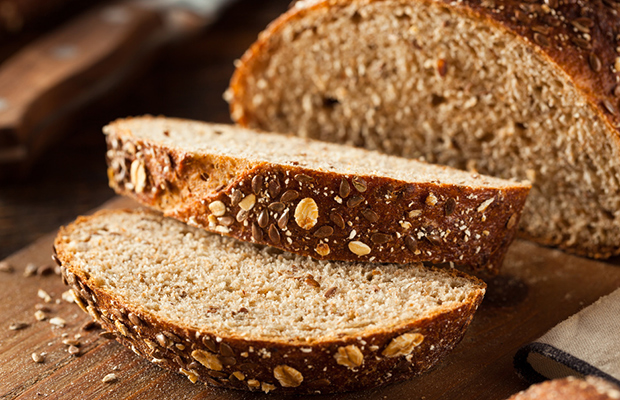
Most of us probably know someone who’s tried going gluten-free in the name of weight loss, better health or fewer tummy troubles. But as that fad has gained steam, so has another trend — going entirely grain-free.
That’s the premise behind The Wheat Belly 10-Day Grain Detox, which criticizes the gluten-free movement for limited thinking. Instead, author William Davis, MD, posits that anybody and everybody can lose weight, feel great, and maybe even ease health problems by completely eliminating all grains (not just gluten) from their diet. That means saying sayonara to rice, cornstarch and most gluten-free desserts, too.
RELATED: Want to Try the Whole30 Diet? Here’s Your Guide, Plus Recipes
The work is the latest in the best-selling Wheat Belly franchise, which has inspired millions of people to cut grains out of their lives. Or at least, it’s inspired them to try — eliminating all grains is no easy feat, since wheat, rice, corn and other grain products can be found in everything from soy sauce, to salad dressing, to most of America’s favorite breakfast foods. (Yep, according to Davis, even whole-grain toast and gluten-free oatmeal need to go).
The latest Wheat Belly book, which comes out November 10, 2015, attempts to make the switch to grain-free living a little easier by offering shopping lists, recipes and tips for what to expect during the transition — and beyond. After all, this is no one-and-done elimination diet. Instead, Davis maintains that people should undertake the detox and then remain grain-free for the rest of their lives — no cheat days allowed. (Read about the pros and cons of cheat days here.)
RELATED: 21 Meal Prep Picks from the Healthiest People on Instagram
The Rationale Behind Grain-Free Living
If going grain-free sounds a little extreme, that’s because it is. But Davis maintains that it will be worth it in the long run. For starters, in evolutionary terms, humans only began eating grains a short time ago, he says. “We’ve had insufficient time to adapt to consumption of this food,” Davis says.
Then there’s the theory that the gliadin protein in wheat, and similar proteins in other grains, have an opioid effect on our brains. Davis posits that these proteins actually trigger an addictive response that increases appetite and may eventually lead to weight gain. Not only that, but Davis points to research that suggests grains may be linked to inflammation, autoimmunity, digestive issues, high blood sugar and poor nutrient absorption. Even whole grains may contribute to inflammation. (Here’s how to know if inflammation is harming your health.)
RELATED: The Truth About How to Lose Belly Fat
For these reasons, The Wheat Belly 10-Day Detox proposes that literally everyone can benefit from trying a grain-free lifestyle, whether through weight loss, the resolution of health issues, or both. But in order to reap these positive rewards, says Davis, people need to make a strict commitment to being 100 percent grain-free.

Inside the 10-Day Detox
That brings us to the question: What should you expect if you want to give grain-free living a go?
The 10-Day Grain Detox “is meant to be a day by day, meal by meal guide that tells you how to eliminate grains from your life,” says Davis. “I tried to make it as easy as possible.” To that end, the book walks readers through the entire process of adopting a grain-free lifestyle, from purging their kitchens of grains, to shopping for wholesome foods, to making grain-free recipes.
RELATED: 6 Reasons Why You Can’t Out-Exercise a Bad Diet
The book includes a clear-cut 10-Day Menu Plan in addition to full recipes for breakfast, lunch, dinner and snacks. Lest detoxers worry that nothing but raw celery makes the list, the recipes in the book sound surprisingly tasty. Buffalo Chicken Wings, Pork Thai Stir Fry, Key Lime Truffles, Eggplant Lasagna, Cream of Broccoli Soup and Apricot Ginger “Granola” (made with nuts instead of oats) all make the cut.
In lieu of calorie counting, the plan advocates consuming whole foods such as organic vegetables, meats, and eggs, raw or dry-roasted nuts and seeds, oils, and limited amounts of dairy products, legumes, dark chocolate and safe sweeteners (like stevia or xylitol). Even baked goods aren’t off the table, as the plan allows for the use of almond meal, coconut flour, chickpea flour, walnut meal and other replacements for traditional flour.
RELATED: How to Stop Food Cravings in 10 Minutes or Less
Davis is up front about the fact that the detoxification process can be uncomfortable — and the real-life testimonials featured throughout the book bear this out. The transition may be especially frustrating for athletes, as performance is likely to drop for up to six weeks while people’s bodies adjust to deriving energy from fats instead of grain-based carbohydrates, says Davis. He recommends nixing workouts for the first 10 days of the detox before gradually adding them back in.
Despite the unappealing aspects of the detox, devotees of the diet testify that eliminating grains helped them lose weight and reduce cravings. Near the end of the detox, Davis says those who follow the strict elimination diet should also start to have more energy and may notice improvements in their mood, skin, digestion and quality of sleep.
RELATED: Gym Time or Meal Time: What Matters Most for Weight Loss?
More than anything else, Davis hopes that readers will want to stick with a grain-free diet because of how good it makes them feel. He wants people to walk away from the book feeling empowered to make changes that benefit their own well-being. “Know that you are capable of an astounding amount of great things in health,” says Davis. “You can do this on your own, and you can accomplish a lot more than you thought.”
